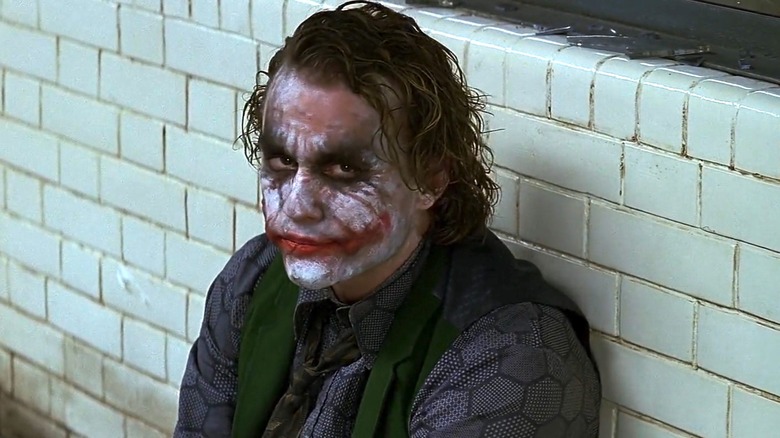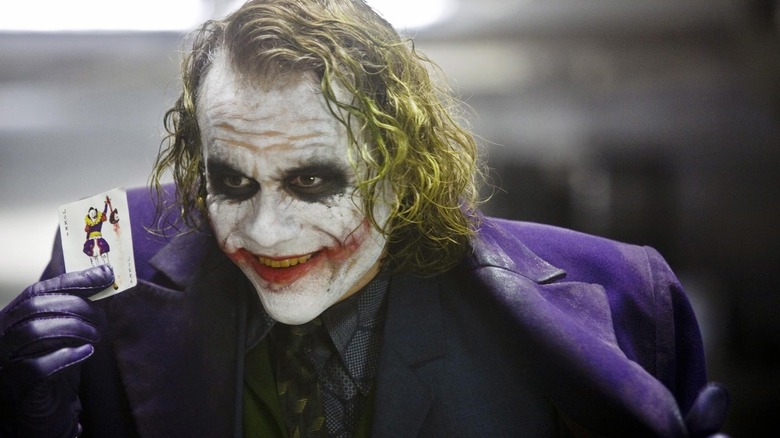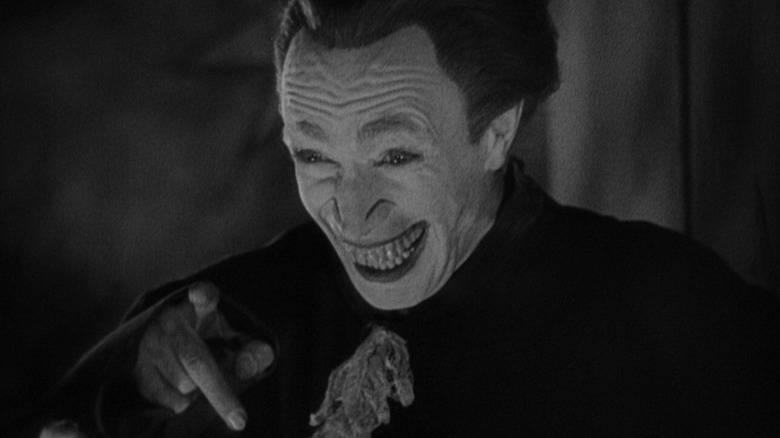The Dark Knight Joker's Scars Were Inspired By A Terrifying Trend That Also Hit Soccer Culture
In Christopher Nolan's 2008 film "The Dark Knight," actor Heath Ledger plays a nameless anarchist who commits multiple acts of murder and arson for the express purpose of sowing chaos in the world. The Ledger character is nicknamed the Joker, as he likes to wear clown makeup and green hair coloring while committing crimes. In a scary aesthetic decision, Nolan made Ledger's clown makeup look like it had been on the character's face for three or four days, leaving it smeared, cracked, and partially wiped off. Additionally, Ledger's face was emblazoned with a pair of scars that stretched outward across his cheeks from the corners of his mouth. His clown smile was literally carved into his face. Because the character is a liar, the audience never knows how he got the scars or why.
Ledger died of a drug overdose in January of 2008 and was not able to see what a massive success "The Dark Knight" would become when it was released in theaters the following July. He would also miss how much "The Dark Knight" would inspire Hollywood to move into superhero movies almost exclusively for the next 15 years. Ledger received a posthumous Academy Award for his performance.
The Joker's facial scars, while unsettling in the film, are actually based on an even more unsettling real-life trend. According to a 2009 issue of Empire Magazine, Ledger's makeup was inspired by the phenomenon of the Glasgow Smile, sometimes called a Chelsea Smile, wherein organized gangs in Scotland would chase down rivals, hold them down, and slash up their faces. Perhaps — to add to the mystery of the character — Ledger's unknowable anarchist was once a member of a Scottish gang.
The scars of a clown
Facial scarification has long been part of the lore of the Joker, stretching all the way back to the character's inception in 1940. It's well known that the Joker was inspired by Conrad Veidt's character from the 1928 film "The Man Who Laughs." The character, Gwynplaine, was accosted by ruffians as a child, and a smile was carved permanently into his face. The scarification trend continued into the 1989 "Batman" film, which saw the Joker as the victim of botched back-alley cosmetic surgery.
The prosthetics supervisor on "The Dark Knight" was Oscar nominee Conor O'Sullivan ("Saving Private Ryan," "X-Men: First Class," "Hatching"). In the Empire article, O'Sullivan explained that his assignment was a little open-ended; he knew the Joker needed scars, but was given no further instructions. He said:
"I was never given a concept or reason for the scarring before I started on the design of the Joker's scars. Once I had it in my mind that it was going to be scars, rather than a fixed smile, I immediately thought of the punk and skinhead era and some unsavory characters I had come across during this time. The terminology for this type of wound is a Glasgow or Chelsea smile."
He immediately remembered encountering someone with a Glasgow Smile and decided to imitate that look:
"My references had to be real. A delivery of fruit machines was made to the estate near my workshop and the man delivering them had a Chelsea Smile. I plucked up the courage to ask him for a photo and he told me the story of how he had got his scars while being involved with 'a dog fight.' Needless to say I didn't pursue the matter, but the photos proved to be very useful reference."
The history of the Glasgow Smile
Other nicknames for a Glasow Smile are a Huyton, a Buck 50, or a Cheshire Grin. According to the website All That's Interesting, the first recorded incidents of a Glasgow Smile as a form of gang-related torture first started appearing in Scotland in the 1830s. During the Industrial Revolution, Glasgow exploded from a small sleepy seaside town to a metropolis full of factories and docks. The population of the city doubled in 50 years, and Glasgow didn't really have the infrastructure to house and care for so many people. As such, many were left impoverished and desperate, leading to the formation of gangs and crime. Over time, gangs began to split along religious lines (Protestants vs. Catholics, mostly), and ruled the streets with whatever makeshift weapons they had at hand, notably razors.
By the 1920s, the Glasgow Smile was a common sight in the town's gang population. It wasn't until the 1930s that a police task force would be formed and gang activity would be halted in earnest.
The 1970s, however, saw the rise of Football Hooligans, that is; gangs that formed out of the fans of a particular English or Scottish football team. Football hooligans, it should be noted, also tended to be white supremacists, and often folded their racist acts of violence into local sports team rivalry. One of the more notorious gangs was the Chelsea Headhunters who re-adopted the Glaswegian facial mutilation tactic for a new generation. Hence, the new name, the Chelsea Smile.
Heath Ledger's anarchist is more interesting if we don't know anything about his past, but it's interesting to think he might have run afoul of the Chelsea Headhunters at some point.


